In some ways, there isn’t much to say about this game that can’t be summed up in a couple of simple sentences. Barcelona attacked relentlessly, and Chelsea Barcelona had all the possession and territory but could only score two goals, Chelsea
But there’s more than that to the game. Yes, Chelsea Chelsea might set up, how they might approach the dangerous situation of trying to take a 1-0 lead through the Camp Nou to the final in Munich
This match gives us an opportunity to illustrate two extremes of football. A veritable siege was laid upon the Chelsea Barcelona Barcelona
The Siege
A picture of Barcelona Chelsea Chelsea
Contrasts in passing
Again, Barcelona typically dominate possession and passing, but the fact that Chelsea were defending a lead, coupled with home advantage, and following England’s Bravest Defender’s dismissal a numerical advantage; the normal patterns for a Barca home game are exaggerated. The images above show passes into the final third. What is extraordinary, apart from the sheer gulf in volume (30 times more as explained above) is that perhaps 6 of Chelsea’s passes into the final third came from within that zone – most attempts came from their own half or just within the Barcelona half; whereas it’s the exact opposite for Barcelona. Very few of the passes come from outside the final third, indicating very well Barca’s patient tiki-taka approach. Yet very few of those passes penetrate the Chelsea box – again displaying the set up of Chelsea
Terry’s dismissal
John Terry is one of the best defenders in England England , but Barcelona
Having already lost Gary Cahill to injury very early in the game, Ivanovic and Bosingwa were tasked with manning the battlements, and they did an outstanding job. Ramires moved to right back, and his athleticism and application were an absolute credit to him – especially given that his booking at the end of the first half rules him out of the final.
In truth the whole team battled strongly throughout the game. Didier Drogba was seen in both full-back positions at different stages of the game. He went from lone front man – an outlet for the long punts up the pitch, to utility defender, plugging gaps and breaking up play before running himself into the ground trying to carry the ball out of danger.
No plan B for Barcelona
The problem with having such a devastating plan A is that a team can run out of ideas when that plan doesn’t work. When Barcelona came up against a team playing (After Terry’s red card) what was effectively a 6-3-0 formation, they couldn’t penetrate by usual methods, but had no way of adapting their play. They were so confident in their patient possession based game that it seemed like it didn’t occur to them to try something different. Barcelona’s characteristic passing accuracy is only let down by their crosses. A team like Chelsea with their tall, strong defenders gobbled up crosses into the box.
Of the successful crosse illustrated above, two were corners that both found Carles Puyol, and two were cross-field balls to the opposite flanks – not into the box. So discounting those, only 1 cross out of 21 found its intended target. That’s in stark contrast to their usual passing percentages.
What Barcelona did do towards the end of the 90 minutes was commit absolutely everyone forward, which left them vulnerable to a break, and when Ashley Cole found Torres he charged unchallenged towards the Barcelona goal and Valdes was expertly rounded leaving a simple task of rolling the ball into the net.
Ramires’ goals just before half time was also crucial. It allowed Di Matteo to go into his half time team talk with a simple message of keep doing what you’re doing.
Chelsea efficency
Barcelona were wasteful with their chances. Only 6 shots on target compared to Chelsea’s 3 – and considering the incredible dominance of Barcelona in other statistical categories, that simply isn’t good enough. Consider too that the one shot that was saved by Valdes was the effort by Drogba from within his own half.
It’s quite remarkable that Chelsea scored from their only two real chances, and three over the two legs.
Remarkable too that Raul Meireles was Chelsea’s top passer with 15 out of 22 attempts successful – putting him behind 10 Barcelona outfield players. Gerald Pique – off injured in the 26thminute – completed more passes than every Chelsea player except Meireles.
Chelsea’s efficiency is typified by Ashley Cole’s contribution to the passing. He was one of Chelsea’s best players on the night, but completed fewer passes than he took throw ins – but one of those passes found Torres who ran on to score.
By Tom Nash @breitnersbeard

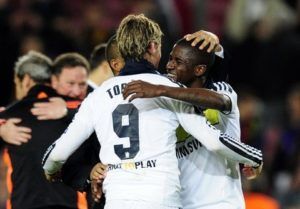
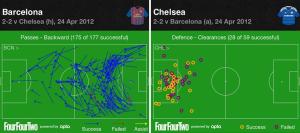
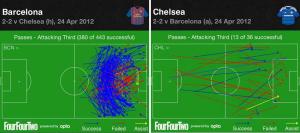
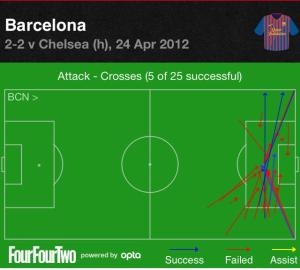
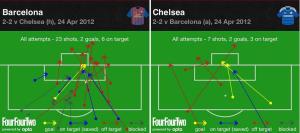








Recent Comments